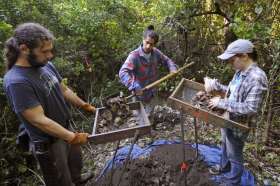In Search of Ft. Caroline
Florida Times Union – October 15th
By Matt Soergel
No one ever said it would be easy to crack the biggest mystery of Fort Caroline: Where is the exact location of the isolated, blood-soaked outpost of the doomed French expedition to the New World?
People have looked for it over the years. But it’s as if it has just vanished, as if there never were that tenuous foothold somewhere on the banks of the St. Johns River.
Still, a team of University of North Florida archaeologists and students kept up the search on Friday, plunging into palmetto thickets, digging through ancient oyster shells, sifting through the thin soil near Spanish Pond, deep inside the Timucuan Ecological and Historic Preserve.
The fort didn’t give up its secret on that day.
But the search will continue: UNF’s team got a $43,000 historic preservation grant from the state to help pay for the hunt. It started work in May and has so far dug and mapped more than 350 exploratory holes. The group will keep looking until April.
It’s a tantalizing goal: Anthropology major David Ardanuy even dreamed the other night about finding French pottery.
“That would tell you we found the fort,” he said. “And finding that would be like striking gold.”
French Protestants built their fort in 1564, before St. Augustine and Roanoke, before Jamestown and Plymouth. They were wiped out 15 months later, victims of a surprise attack by Spanish soldiers who slogged through a hurricane from their new stronghold at St. Augustine.
UNF professors Robert “Buzz” Thunen and Keith Ashley figure it’s somewhere between Queens Harbor and Mill Cove. They and others have dug all around there, including the land near the replica fort in the national park.
Nothing. So they’re concentrating on places that have perhaps been overlooked over the years. This new push has been on national park property and will soon expand, they hope, onto some private property in nearby subdivisions.
Even if they don’t find anything, it won’t be a total loss.
As Sherlock Holmes liked to say: When you have eliminated the impossible, whatever remains, however improbable, must be the truth.
“We want to say at the end that we know where it’s not,” said Thunen.
Of course, he said, it could be under the St. Johns River, a victim of erosion. In which case it would almost certainly be lost forever.
“People have been looking for a long, long time and not one shred of evidence has been found,” said Ashley, his colleague.
Then he corrected himself. There is now one shred.
It’s a piece of French pottery from that period that was recently uncovered in a 50-year-old collection at the University of Florida. It came from a man named William Jones, who found it somewhere in the Fort Caroline area. But Jones is no longer alive, so no one knows where he picked it up.
So the mystery continues.
UNF students, however, didn’t go away empty-handed Friday. Anthropology major Chris Rangel found several large pieces of broken pottery, pulling them out of a bed of oyster shells about a foot below the surface.
His were almost certainly the first human hands to have touched the pottery since someone left it on a garbage pile, 1,200 to 1,500 years ago, long before the French.
“I think that’s the main reason everyone comes to dig,” Rangel said. “That’s the excitement that keeps students coming, even when it’s hot — finding bones, or projectile points, which are rare. Or a fort.”
